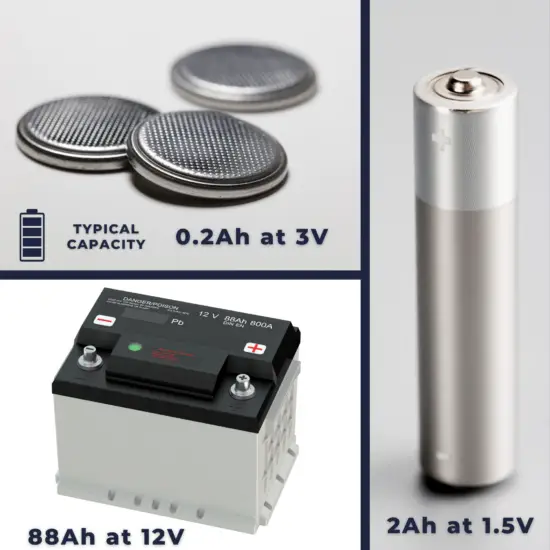30-second summary
Capacity of Batteries
Different battery chemistry and size creates different cell voltage and capacity.
- 0.2 Ah. CR2032 batteries use lithium manganese oxide technology to deliver a nominal voltage of 3V with a capacity of 210mAh. These coin cells have a diameter of 20mm and a thickness of only 3.2mm.
- 2 Ah – A typical alkaline or NiMH battery in the standard “AA” size has about 2000 to 3000 mAh (or 2 to 3 Ah).
- 3 Ah – Lithium Iron Disulfide (Li-FeS2) AA batteries are non-rechargeable batteries, featuring a nominal voltage of 1.5 volts and a typical capacity of 2700-3300 mAh, with some models having capacity up to 3500-3600 mAh.
- 3 Ah – Almost all lithium-ion batteries work at 3.8 volts. Lithium-ion 18650 batteries generally have capacity ratings from 2,300 to 3,600 mAh.
- 70 Ah – A common voltage for automobile batteries is 12 volts (DC). But this battery consists of six 2V lead cells. An average automotive battery might have a capacity of about 70 Ah, specified at a current of 3.5 A. This means that the amount of time this battery could continuously supply a current of 3.5 A to a load would be 20 hours (70 Ah / 3.5 A).

An electric battery is essentially a source of DC electrical energy. It converts stored chemical energy into electrical energy through an electrochemical process. This then provides a source of electromotive force to enable currents to flow in electric and electronic circuits. A typical battery consists of one or more voltaic cells.
The fundamental principle in an electrochemical cell is spontaneous redox reactions in two electrodes separated by an electrolyte, which is a substance that is ionic conductive and electrically insulated.
Capacity of Batteries

The coulometric capacity of a battery is the total Amp-hours available when the battery is discharged at a certain discharge current from 100% SOC to the cut-off voltage. It is determined by the amount of active material contained and represents the maximum amount of electrochemical energy that can be extracted from the battery.
Different battery chemistry and size creates different cell voltage and capacity.
- 0.2 Ah. CR2032 batteries use lithium manganese oxide technology to deliver a nominal voltage of 3V with a capacity of 210mAh. These coin cells have a diameter of 20mm and a thickness of only 3.2mm.
- 2 Ah – A typical alkaline or NiMH battery in the standard “AA” size has about 2000 to 3000 mAh (or 2 to 3 Ah).
- 3 Ah – Lithium Iron Disulfide (Li-FeS2) AA batteries are non-rechargeable batteries, featuring a nominal voltage of 1.5 volts and a typical capacity of 2700-3300 mAh, with some models having capacity up to 3500-3600 mAh.
- 3 Ah – Almost all lithium-ion batteries work at 3.8 volts. Lithium-ion 18650 batteries generally have capacity ratings from 2,300 to 3,600 mAh.
- 70 Ah – A common voltage for automobile batteries is 12 volts (DC). But this battery consists of six 2V lead cells. An average automotive battery might have a capacity of about 70 Ah, specified at a current of 3.5 A. This means that the amount of time this battery could continuously supply a current of 3.5 A to a load would be 20 hours (70 Ah / 3.5 A).
Capacity is calculated by multiplying the discharge current (in Amps) by the discharge time (in hours). It depends on certain conditions:
- Temperature. Typically, at higher temperatures, the performance of the battery is higher than at lower temperatures because the electrochemical reactions are less efficient. As a result, the energy extracted is lower than expected. High and low temperatures have different effects on battery life. Li-ion cells have an optimal temperature operating range, and outside this range, the battery cell undergoes severe loss of capacity.
- The life cycle of the battery. Battery life (and its synonym battery lifetime) has two meanings for rechargeable batteries but only one for non-rechargeables. For rechargeables, the life cycle can mean either the length of time a device can run on a fully charged battery or the number of charge/discharge cycles possible before the cells fail to operate satisfactorily. The active material on the battery plates changes the chemical composition on each charge and discharge cycle. Degradation usually occurs because electrolyte migrates away from the electrodes or because active material detaches from the electrodes. Low-capacity NiMH batteries (1,700–2,000 mA·h) can be charged some 1,000 times, whereas high-capacity NiMH batteries (above 2,500 mA·h) last about 500 cycles. NiCd batteries tend to be rated for 1,000 cycles before their internal resistance permanently increases beyond usable values. Fast charging increases component changes, shortening battery lifespan. If a charger cannot detect when the battery is fully charged, then overcharging is likely, damaging it.
- Charging and discharging rate. If a battery is discharged using a high current, the capacity is reduced because the amount of active material that had time to react is less than would be if the discharge current was lower, letting the electrodes react more effectively with the electrolyte extracting more energy from the battery and therefore having a higher capacity. The C-rate is a measure of the rate at which a battery is being charged or discharged. Typically, maximum capacity is found at a low C-rate, and charging or discharging at a higher C-rate reduces the usable life and capacity of a battery. Manufacturers often publish datasheets with graphs showing capacity versus C-rate curves.
Battery capacity and parallel connection
Batteries wired in parallel will have their capacities (measured in amp-hours) added together. However, the total available energy (measured in watt-hours) in both configurations is the same. For example, wiring two 12-volt batteries with 100 Ah capacities in series will output 24 volts with a 100 Ah capacity.
Energy Capacity of Batteries – Wh
The “energy capacity” of the battery is the total Watt-hours available when the battery is discharged at a certain discharge current (specified as a C-rate) from 100% SOC to the cut-off voltage. Energy is calculated by multiplying the discharge power (in Watts) by the discharge time (in hours). Like capacity, energy decreases with increasing C-rate.
Other Characteristics
To compare and understand the capability of each battery, some important parameters are characteristic of each battery, also within a type of battery. These parameters are a reference when a battery is needed, and specific qualities are required since batteries are used in all types of devices and for infinite purposes.
Cell Voltage
The voltage of electric batteries is created by the potential difference of the materials that compose the positive and negative electrodes in the electrochemical reaction.
Cut-off Voltage
The cut-off voltage is the minimum allowable voltage. It is this voltage that generally defines the “empty” state of the battery.
Capacity
The coulometric capacity is the total Amp-hours available when the battery is discharged at a certain discharge current from 100% SOC to the cut-off voltage.
C-rate of Battery
The cut-off voltage is the minimum allowable voltage. It is this voltage that generally defines the “empty” state of the battery.
Self-discharge
Batteries gradually self-discharge even if not connected and delivering current. This is due to non-current-producing “side” chemical reactions that occur within the cell even when no load is applied.
Degradation
Some degradation of rechargeable batteries occurs on each charge–discharge cycle. Degradation usually occurs because electrolyte migrates away from the electrodes or because active material detaches from the electrodes.
Depth of Discharge
Depth of discharge is a measure of how much energy has been withdrawn from a battery and is expressed as a percentage of full capacity. For example, a 100 Ah battery from which 40 Ah has been withdrawn has undergone a 40% depth of discharge (DOD).
State of Charge
The state of charge refers to the amount of charge in a battery relative to its predefined “full” and “empty” states i.e. the amount of charge in Amp-hours left in the battery.









